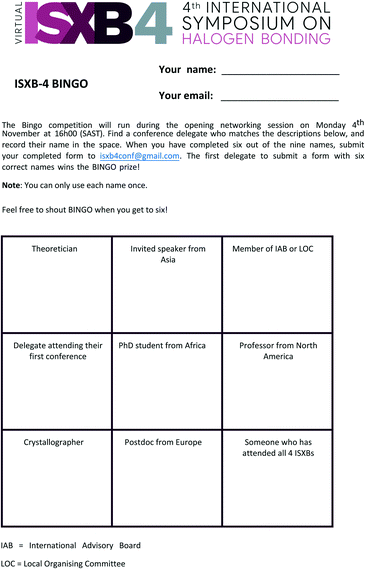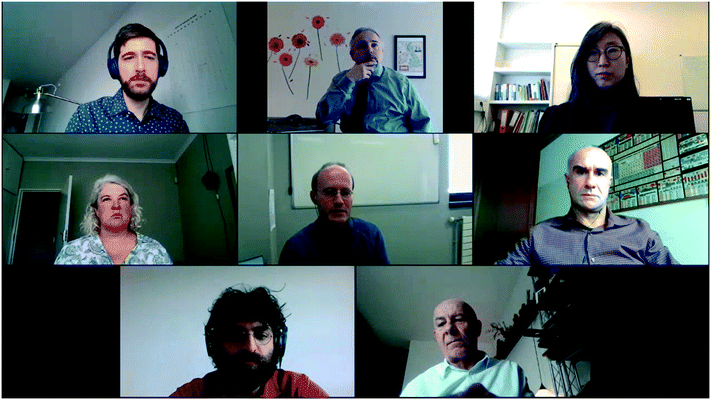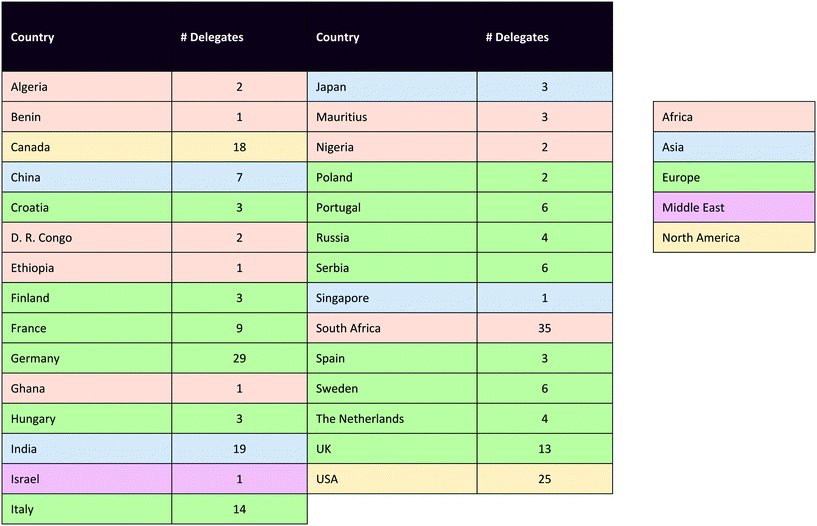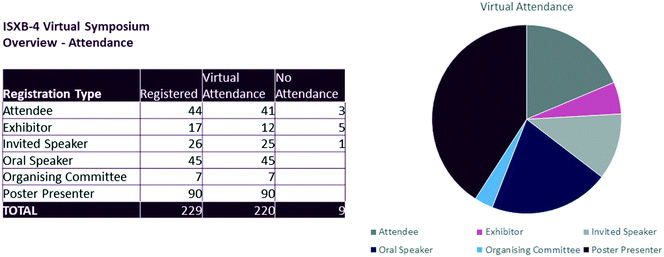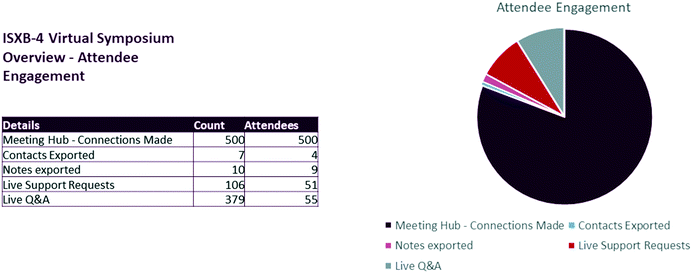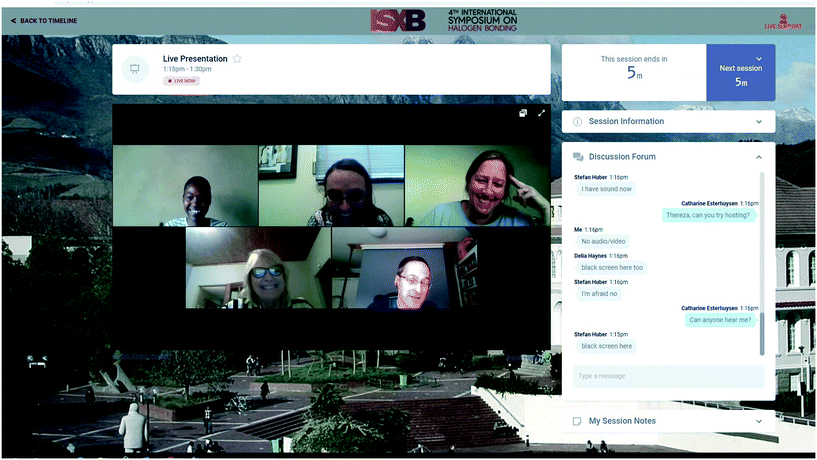Conferences in the time of COVID: Perspectives on organising ISXB-4 Virtual
Catharine
Esterhuysen
 *
*
Department of Chemistry and Polymer Science, Stellenbosch University, Private Bag X1, Matieland, Stellenbosch, 7602, South Africa. E-mail: ce@sun.ac.za
Of course, by June it was clear that “it” would not all be over by November, so again the discussions with the ISXB-IAB started. With the ISXB-5 in Japan and ISXB-6 in Croatia waiting to go ahead in 2022 and 2024, respectively, it was decided that to keep postponing to some nebulous date in the future when travel would be possible would interfere with the organisation of future meetings. It was therefore decided that the conference should be moved online: ISXB-4 Virtual was born.
The first International Symposium on Halogen Bonding, held in June 2014 in the lovely Italian seaside town of Porto Cesareo, brought together scientists from a variety of backgrounds and a broad range of interests to discuss halogen bonding and related interactions. This symposium was brilliantly organised by Pierangelo Metrangolo and Giuseppe Resnati, who, in addition to lining up an excellent array of speakers, showcased the local hospitality with superb dinners and a wonderful excursion to visit the nearby historical city of Lecce. This symposium thus served as the benchmark for the following meetings in the series with regard to excellent science and enjoyable social events. These high standards were maintained by the ISXB meetings in Gothenburg, Sweden, and Greenville, SC, USA, both of which were characterised by top-quality presentations on a wide range of topics in fields such as medicinal chemistry, chemical biology, materials science, catalysis, crystal engineering and industrial applications from both theoretical and experimental viewpoints. In addition, the social programmes formed an integral part of the meetings. This social aspect has meant that, since many of the delegates have attended all of the meetings in the series, the attendees have formed a close-knit family of scientists from all over the world brought together by their fascination with halogen bonding.
The greatest challenge in organising such an online conference, therefore, was to retain that sense of community despite only seeing each other through a computer screen. The potential disconnect was further exacerbated by the delegates being in vastly different time zones, with stalwarts of the series coming from as far afield as Chiba, Japan and Vancouver, Canada. We therefore needed to consider how to ensure that no-one missed out on scientific presentations or social events, i.e. to schedule all events at reasonable times for all time zones. After much consideration, we realised that the solution was to have shorter, live sessions with fewer online presentations but more online discussions, such that we could assign the participants involved in each session according to time zones. In addition, we realised that we needed to give the attendees many opportunities for social and scientific interaction during the conference.
To this end, the conference started with a welcome function on 2 November 2020 at 15:30 local South African time (14:30 CET, 22:30 JST, 05:30 PST). After an inspiring talk from one of the ISXB's founders, Pierangelo Metrangolo, the usual “meet-and-greet” event at the start of the conference took the form of an hour of “speed greeting”: delegates were randomly allocated to “tables” of five people to chat for five minutes before being moved to a different “table”. As an added challenge, delegates could use the encounters to complete “bingo cards” where they were encouraged to identify fellow delegates who met the descriptions on the card (see Fig. 1). In the end, an hour was too little to greet all the old friends, but it was still a lovely opportunity to speak to many people and make some new acquaintances.
The business part of the conference started on 3 November 2020 and consisted of six sessions: the ‘Nature of X-bonding’ and ‘Supramolecular chemistry and crystal engineering’ on 3 November, ‘Solid state properties’ and ‘Understanding X-bonding behaviour’ on 4 November, and ‘Applications in synthesis, catalysis and industry’ and ‘Applications in solution chemistry and biology’ on 5 November. Most delegates contributed to these sessions through pre-recorded talks that were made available to all delegates in the week prior to the conference. Each session consisted of two or three live speakers followed by a half-hour discussion session. Delegates were encouraged to watch the pre-recorded talks prior to the sessions, as the focus of the sessions was the discussion involving the live speakers and the presenters of pre-recorded invited and contributed orals, moderated by an ISXB-IAB member. The discussion sessions led to some lively debates as presenters answered questions sent by the delegates through a question-and-answer chat function (Fig. 2).
The timing of the sessions was deliberately chosen to take the time zones of the presenters contributing to a session (either as live speakers, or as pre-recorded speakers involved in the discussion sessions) into account: earlier sessions were dominated by delegates from the Eastern hemisphere, Europe and Africa, while delegates from Canada, USA, Europe and Africa contributed to later sessions. Similarly, there were two poster sessions, the first on 3 November 2020 for presenters from the Western hemisphere, Europe and Africa, while delegates from China, Japan, India and the Middle East were assigned to the second poster session, early on 4 November 2020. Each poster presentation consisted of a pdf-format poster and a three-minute flash presentation, which were made available to all delegates in the week prior to the conference. In addition, for each poster there was a dedicated question-and-answer chat function so that delegates, particularly those who were in a time zone that would make attending the poster session difficult, could leave questions that could in turn be answered by the presenters through the chat function. The poster sessions themselves then gave delegates the opportunity to speak directly to the poster presenters about their work. Despite the unusual format of the posters, the judges of the poster awards agreed that the standard was extremely high, making the task of choosing prize winners extremely difficult. In the end, the following poster prize winners were announced:
Vinu Panikkattu (Kansas State University, USA)
Somananda Sanyal (Stellenbosch University, South Africa, CrystEngComm poster prize)
Toni Spilfogel (McGill University, Canada)
Alessandro Marchetti (Politecnico di Milano, Italy)
Remya Ramakrishnan (IISER TVM, India)
The online format also allowed more young scientists to contribute oral presentations than is the norm, so CrystEngComm kindly sponsored prizes for the two best oral presentations. These were awarded to Rafael Nunes of the University of Lisbon, Portugal, and Asia-Marie Riel of the University of Montana, USA.
As promoting the social interaction between delegates had been one of our motivating factors in organising the symposium, we made sure that there were plenty of opportunities for attendees to meet and chat. We wanted to ensure that delegates could get together at any time, either on a one-to-one basis or as a group, but also have informal get-togethers as one would usually do over a coffee break at a conference. The latter aspect we addressed by ending each day with a networking session where four ‘rooms’ were available that delegates could enter to chat with everyone that was there. They were also able to leave and move to other rooms if they wanted to. On some days these chat rooms were assigned to specific groupings, such as young scientists, but on others they were a ‘free-for-all’. These were well utilised, with many delegates staying in the rooms for up to an hour after the end of the scientific programme to chat. For many delegates who were under lockdown at that stage it was an opportunity to catch up with colleagues from their own groups. A second means of delegates getting together was through a “Meeting Hub”.
The online platform we chose gave delegates the opportunity to arrange to meet and chat, either individually or in groups. Each presentation also had an associated question and answer facility, which allowed delegates to discuss the presentations by text chat and, if necessary, follow up by a direct meeting through the meeting hub.
To encourage participation, we utilised the gamification functionality available on the online platform with the promise of a prize. This allowed us to award points to participants for attending and contributing to events and undertaking activities such as meeting sponsors or making contacts through the meeting hub. Further points could be earned by participating in a fun daily quiz with topical questions.
Attendance statistics
ISXB-4 Virtual was attended by 220 delegates from 29 different countries (Table 1), as compared to 88 registrations from 19 countries for the on-site meeting which would have been held in Stellenbosch, South Africa. Happily, the greatest increase in delegate numbers was from African countries, where the online format enabled the attendance of many first-time attendees for whom travel is difficult and expensive. The increase in numbers was particularly the result of a far greater number of student delegates attending; a third of the delegates were postgraduate students, although there were also representatives from each career stage, from undergraduates to senior academics. The reasons for this were, firstly, because the costs involved with attending the online meeting were significantly lower than the on-site conference, and secondly owing to us being able to sponsor the attendance of a large number of young scientists through the generous support of the International Union of Crystallography (IUCr) and the European Crystallographic Association. This, in turn, had the effect that there were a large number of poster presenters (Fig. 3).One of conditions of the IUCr funding was that the ISXB-4 should foster gender equality; a cause that the ISXB-4-OC (consisting of four women and two men) enthusiastically supported. Our aim (as declared in our Diversity Statement) was to “achieve gender balance in all its institutions and activities bearing in mind other diversity needs and its existing obligations to geographic and academic discipline representation where appropriate”. We were, therefore, pleased to find that 32% of the participants were women and 67% were men (with the remaining 1% preferring to self-describe or not to answer).
The online format also enabled us to get very detailed statistics regarding the attendance of each event and presentation (including the pre-recorded oral and poster presentations), as well as participation in networking sessions, use of the meeting hub and visits to each sponsor. For instance, the number of delegates attending each live session is shown in Table 2. The number of delegates attending each session remained fairly constant, and there was very little drop-off as compared to what often happens at on-site conferences (particularly those in attractive venues!). Of particular note is the large number of participants who attended the networking sessions at the end of each day, showing that we achieved our goal of encouraging social interaction between delegates.
| Day 1 | |
|---|---|
| Welcome and opening address | 156 |
| Ice-breaker – networking | 122 |
| Day 2 | |
|---|---|
| Nature of hypervalent bonding | 126 |
| An ab initio study of halogen bonded complexes containing some cyclic ethers | 124 |
| Discussion session – nature of X-bonding | 119 |
| Harnessing halogen bonding to fine-tune the properties of the molecular solid solution systems | 128 |
| Resorcinarene salts, multivalent halogen bond synthon for discrete and polymeric assemblies | 124 |
| Discussion session – supramolecular chemistry and crystal engineering | 116 |
| Networking – day 2 | 82 |
| Day 3 | |
|---|---|
| Halogen vs. hydrogen bonding in inclusion compounds | 131 |
| Supramolecular chemistry and photochemistry of halogen-bonded azobenzene solids | 122 |
| Discussion session – solid state properties | 118 |
| Cooperativity in hydrogen and halogen bonds | 132 |
| Theoretical studies of halogen-bonded cocrystallization using periodic DFT calculations | 114 |
| Discussion session – understanding X-bonding behaviour | 100 |
| Networking – day 3 | 68 |
| Day 4 | |
|---|---|
| Halogen bonding in chiral cations | 114 |
| Influence of halogen bonding in M–Cl substitution processes and C–Cl activation reactions | 118 |
| Catalysis halogen bonding in iodine industry | 108 |
| Discussion session – applications in synthesis, catalysis and industry | 100 |
| Halogen bond assisted electrocatalysis | 98 |
| Conformational control with halogen and hydrogen bonds | 128 |
| Discussion session – applications in solution chemistry and biology | 109 |
| Closing | 123 |
| Networking – day 4 | 57 |
Finally, the online platform allowed us to determine the attendee engagement, i.e. the utilisation of the platform's functionalities (Fig. 4). However, we realised during the course of the conference that some of the delegates had overused some of the functionalities to get points in the hope of winning a prize, so these statistics, particularly with regard to the meeting hub and live Q&A, may be skewed.
Advice and lessons learnt
Since it is likely that online conferences will be here to stay, we would like to end this editorial comment with some suggestions for future organisers based on lessons that we as the ISXB-4 local organising committee have learnt:1. Organising committee
Probably the most important aspect of running a successful online conference is to make sure you have a fantastic organising committee: the ISXB-4-OC had to organise the same conference twice from scratch within the space of a year, and they did it without complaints and with so much enthusiasm, even in between suddenly having to put lectures online and support postgraduate students through lockdown.
2. Conference organiser
Do not be tempted to think that you don't need a professional conference organiser because you are going online; an online conference is just as much work as an on-site conference and having someone who can put together daily timelines as to who needs to do what, liaise with the online platform owners and assist delegates is invaluable.
3. Choice of online platform
Choosing a professional platform with loads of functionality improves the experience for all delegates and allows them to feel like they are at a ‘real’ conference. A series of Zoom presentations is simple and cheap, but does not encourage participation. For us, the key was finding a good platform that could deal with the live presentations, pre-recorded talks and poster sessions, and also offer ample networking opportunities. Don't skimp on this; the expense is worth it!
4. Testing the platform
Most online platforms are focussed on industry conferences, which have very different requirements with regard to functionality and approach. We found that choosing an online platform run by technical people who were willing to be flexible was key. In addition, thorough and rigorous testing prior to the event was needed. Our first test of the platform was completely disastrous; people couldn't connect and then nothing worked. We found that several rounds of testing involving the LOC and the IAB were needed before the everything worked as we envisaged. Fig. 5 shows the ISXB-4-OC and ISXB-4-IAB members testing the discussion function.
5. Good communication
We found that behind-the-scenes communication between the organisers during the conference was even more important than at an on-site conference, so that we could quickly identify when something was going wrong and then make a plan to solve the issue. We found the easiest way was to have a WhatsApp group involving the ISXB-LOC, the platform managers and student helpers.
6. Training on the platform
Although the platform was very powerful it was not very intuitive to use; we found that training all of the people involved in any live presentations and discussions was very important. We also realised that all of the members of the LOC needed to be familiar with the functionalities for making announcements etc. so that if a crisis arose anyone could step in and deal with the issue.
7. Gamification
The gamification aspect definitely encouraged students to participate; for instance, we found that many more students posed questions during live sessions than would normally do so at an on-site conference. This was aided by the anonymity of a chat box, but we are convinced that the gamification helped. However, be aware that there may be some delegates who will take advantage and attempt to ‘play the system’. We didn't think of this beforehand, but with hindsight we would have put in limits to discourage this kind of behaviour and also made it clear that we would not award prizes to delegates who spammed attendees simply to gain points.
8. Platform functionality
The platform that we used was very powerful and we didn't sufficiently tap into all of the possibilities. For instance, we could have instituted ‘delegates choice’ prizes for presentations, while the statistical analysis of the virtual attendance was a very useful aspect that we could have used more.
9. Costs
A professional online platform is expensive but definitely worth it, as mentioned above. Nevertheless, attendees expect online conferences to be free, so there needs to be a balance. We unfortunately needed to recoup some expenses resulting from the original ISXB-4 on-site meeting (conference bags, etc.) so had to charge a fee, but one of the advantages of a good, professional online platform is that it offers excellent opportunities for sponsors in the form of exhibitors' booths. This means that sponsors get greater exposure and more value for money, along with greater opportunities to network with delegates than would be possible at an on-site conference. Some of the costs can therefore reasonably be expected to be covered by sponsors.
10. Student support
By far the largest group of delegates at ISXB-4 was the young scientists: 114 of the 220 delegates, up from just 38 (less than half of the registered attendees) for the on-site meeting. Typically, travel to exotic locations is too expensive for students, whereas online attendance is more affordable. Making additional funding available to support the attendance of young scientists particularly further empowers scientists from poorer countries to be able to attend.
In conclusion, although an online conference may not be as exciting as an on-site meeting in an exotic location, it offers many advantages. Our experience was that the delegates at ISXB-4 Virtual had an enjoyable and valuable scientific experience and felt like they had attended a “real” conference. In addition, the delegates agreed that the registration fee had been more than justified as the online platform had substantially contributed to their enjoyment of the event.
Post script
With the successful completion of ISXB-4 Virtual, all that remained for the local organising committee was to dispose of the conference bags and water bottles that remained from the original on-site meeting. The excursion planned for the conference in Stellenbosch had been a visit to the wine estate Villiera to taste their award-winning wines, tour their cellar and take a game drive through their wildlife sanctuary. The final stop in the excursion was to have been the Pebbles project, a non-profit organisation committed to educating and enriching the lives of disadvantaged children and families in the Winelands farming communities in the Western Cape. Since Villiera had been extremely generous in accommodating the conference (and understanding when it was moved online!), it seemed fitting that the Pebbles project should be the recipients of the bags and bottles (Fig. 6). The conference bags and bottles will be used during camps and educational excursions for the children when these are possible again.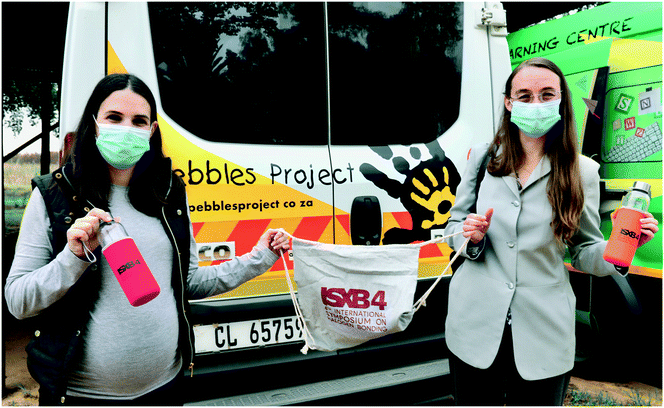 | ||
| Fig. 6 ISXB-4-LOC chair, Catharine Esterhuysen, handing over the ISXB-4 conference bags and bottles to Rachel Ward da Costa of the Pebbles project at Villiera Wine Estate. | ||
Acknowledgements
The ISXB-LOC members deserve a huge round of applause for their hard work in organising the same event twice from scratch; our sincere thanks go out to Delia Haynes (Stellenbosch University, co-chair), Rehana Malgas-Enus (Stellenbosch University, treasurer), Nikoletta Báthori (Cape Peninsula University of Technology), Jan Dillen (Stellenbosch University) and Gerhard Venter (University of Cape Town), as well as Thereza Botha (conference organiser) and Somananda Sanyal and Alan Eaby (Stellenbosch University) for their help with testing the platform and their enthusiastic tweeting. We would also like to thank the ISXB-IAB, chaired by Pierangelo Metrangolo, for their tremendous support in all the difficult decision making, and particularly the past and future ISXB chairs, Máté Erdélyi (ISXB-2), Bill Pennington (ISXB-3), Tatsuo Kaiho (ISXB-5) and Marijana Đaković (ISXB-6) for their advice with the ISXB-4 organisation. We would also like to thank our sponsors, particularly CrystEngComm, for their generous support of the conference.| This journal is © The Royal Society of Chemistry 2021 |

